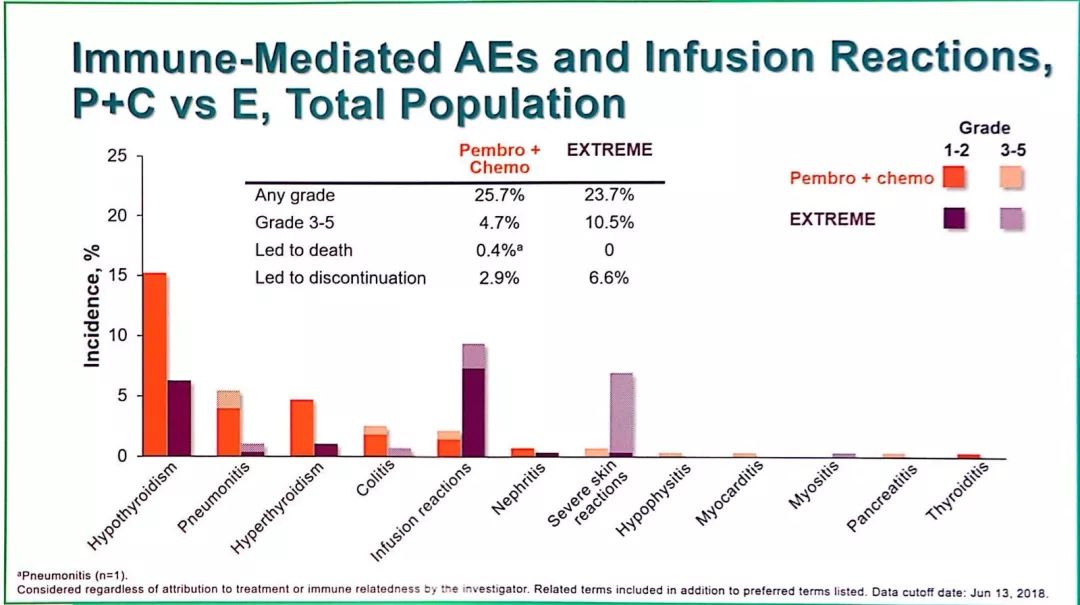
For patients with low CPS, treatment with pembro-chemo was associated with a trend toward shorter PFS (HR, 1.42 95% CI, 0.91-2.23 P = .12) compared with cetux-chemo, and treatment with pembro-mono was associated with significantly shorter PFS (HR, 2.17 95% CI, 1.38-3.42 P = .001) ( Figure 1D, 2C-D). For patients with intermediate CPS, treatment with pembro-chemo was associated with similar PFS (HR, 0.92 95% CI, 0.71-1.19 P = .51), and treatment with pembro-mono (HR, 1.55 95% CI, 1.20-2.00 P = .001) was associated with shorter PFS compared with treatment with cetux-chemo ( Figure 1C and Figure 2, C and D). Next, we examined the interaction between treatment arm and CPS category regarding PFS ( Figure 1, C and D, and Figure 2, C and D). Tests for interaction between CPS group and treatment arm were significant for treatment with pembro-chemo vs cetux-chemo ( P = .003) and pembro vs cetux-chemo ( P = .03) (supporting data reported in Figure 2, C and D). For patients with low CPS, neither treatment with pembro-chemo (HR, 1.13 95% CI, 0.71-1.80 P = .60) nor pembro-mono (HR, 1.4 95% CI, 0.89-2.20 P = .14) was associated with improved OS vs treatment with cetux-chemo ( Figure 1B and Figure 2, A and B). For patients with intermediate CPS, treatment with pembro-chemo (hazard ratio, 0.69 95% CI, 0.52-0.91 P = .01) but not pembro-mono (HR, 0.86 95% CI, 0.66-1.12 P = .25) was associated with improved OS compared with treatment with cetux-chemo ( Figure 1A and Figure 2, A and B). The CPS was associated with OS for patients treated with pembro-mono and pembro-chemo, but not cetux-chemo.

Combined, these subsets represented 57% of the Keynote 048 study population.

Because the response to treatment with pembrolizumab is associated with CPS in RM HNSCC, 2 there is concern that the clinical outcomes for those in the pembrolizumab-containing arms may be attenuated or reversed in the intermediate and low CPS groups. The authors reported overall survival (OS) analyses for the total population, those with a CPS of 20 or greater, and those with a CPS of 1 or greater, but to our knowledge, data on outcomes for patients with an intermediate (1-19) or low (<1) CPS have not been previously published. 1 Patients were randomized (1:1:1) to receive treatment with pembro-mono, pembro-chemo, or cetuximab with chemotherapy (cetux-chemo), and were stratified by the combined positive score (CPS), a measure of programmed cell death–ligand 1 staining.
#Keynote 048 results plus#
Keynote 048 ( NCT02358031) established the benefit of treatment with pembrolizumab monotherapy (pembro-mono) and pembrolizumab plus chemotherapy (pembro-chemo) for recurrent and metastatic head and neck squamous cell carcinoma (RM HNSCC). Shared Decision Making and Communication.Scientific Discovery and the Future of Medicine.Health Care Economics, Insurance, Payment.Clinical Implications of Basic Neuroscience.Challenges in Clinical Electrocardiography.


 0 kommentar(er)
0 kommentar(er)
